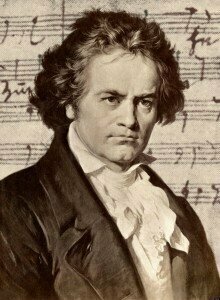
Beethoven
Beethoven: Piano Sonata No. 14 in C-Sharp Minor, Op. 27, No. 2, “Moonlight” – I. Adagio sostenuto
Many composers wrote for one instrument alone, the epitome of intimate communication between the performer and every single attendee. The piano immediately comes to mind, especially Beethoven’s piano sonatas, which run the gamut of all emotions. The pathos of Sonata No. 14 in C-sharp minor Op. 27, the “Moonlight” sonata will melt your heart. But many instruments sound wonderful by themselves. Enrique Granados wrote 12 Spanish dances, for solo classical guitar. The Oriental, No. 2, is exquisite.
Granados: 12 Danzas españolas (Spanish Dances), Op. 37: No. 2. Orientale
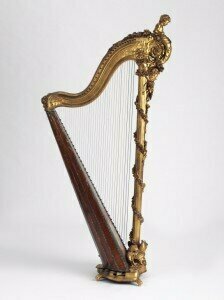
Pedal harp from Victoria and Albert Collection V&A by Georges Cousineau born 1733.
Debussy : Danse sacrée et danse profane
Mozart: Flute Concerto No. 2 in D Major, K. 314
The harp? French composer Claude Debussy wrote his Danse sacrée et Danse profane for only five players—string quartet and harp—but the results are heavenly. The flute? Listen to Mozart’s Concerto for Flute No. 2 in D and so many people tell me how much they love the cello—the closest sound to the human voice. Listen to the wide range of interesting sounds my teacher János Starker makes in the Bartók Rumanian Folk Dances.
Bartok: Rumanian Folk Dances
Do you like lullabies?
Brahms : Lullaby (Anne-Sophie Mutter)
Listen to perhaps the most famous lullaby ever by Johannes Brahms. Polish virtuoso pianist and composer Frédéric Chopin wrote an exquisite Berceuse Op. 57 in D Flat Major, for solo piano. His poetic genius is quite evident and this piece is played by all the greatest pianists ever since it was composed in 1843.
Chopin: Berceuse in D-Flat Major, Op. 57
Perhaps you’ll be thrilled by virtuoso music?
Piazzolla: Libertango
Piazzolla: Libertango for 12 Cellos
Look no further than Argentine composer Astor Piazzolla, known for his infectious tango music and his brilliant playing on the bandoneon—a type of concertina similar to the accordion, but with a very distinctive sound. Libertango is one of his famous works. Hear the master himself play at 2 minute 40 seconds. All types of instrumentalists play his music and I love this terrific arrangement for 12 cellos. Manuel de Falla’s Ritual Fire Dance from El Amor Brujo will also get your blood boiling, here in an arrangement for violin and piano.
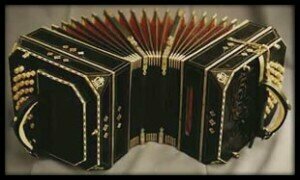
Bandoneon
Do you relish the overwhelming, powerful sound of the organ and Baroque music?
Then I suggest this stunning rendition of J.S. Bach’s Toccata and Fugue in D Minor.
Bach: Toccata and Fugue in D Minor, BWV 565
Or are you in the mood for meditation?
Purcell: Dido and Aeneas, Z. 626, Act III: When I am laid in earth
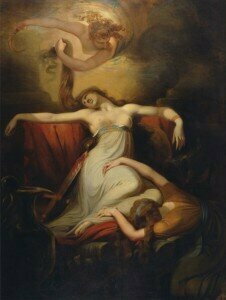
Painting of Dido by Henry Fuseli, 1781, oil on canvas.
© Yale Center for British Art, New Haven, CT
Glass: Echorus
Pärt: Spiegel im Spiegel
Perhaps you prefer music for piano and strings, of three or four, sometimes five players?
Haydn: Keyboard Trio No. 25 in G Major, Hob.XV:25, “Gypsy Trio” – III. Rondo all’Ongarese: Presto
Haydn composed an immense number of works for all combinations of instruments including 68 string quartets, but like many composers, he wrote a number of trios for piano, violin and cello. The movement Al’Ongarese from his Keyboard Trio No. 25 in G Major, Hob.XV:25, the so-called Gypsy Trio is infectious and intended to emulate Hungarian Gypsy music. Compare this to Johannes Brahms’ similar undertaking in his Piano Quartet in G Minor Op. 25, for piano, violin, viola and cello. Brahms played the piano part in this piece for his 1862 debut in Vienna. Here is his Rondo alla Zingarese—denser, full of passion, and foot stopping breathless dancing—obviously from the romantic period of musical composition.
Brahms: Piano Quartet No. 1 in G minor – Rondo alla Zingarese
Do you think you would enjoy the string quartet—music for four string players?
Shostakovich: String Quartet No. 8 in C Minor, Op. 110
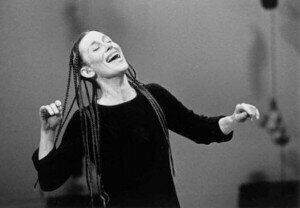
Meredith Monk
Or would you rather hear wind instruments?
Another much-loved piece, and in a completely different mood, is the Antonin Dvořák Serenade for Wind Instruments and cello and bass Op. 44. Get close up and personal with two oboes, two clarinets, two bassoons, the grand-daddy contra-bassoon, and three brass players represented by French horns. It’s in Slavonic style, teaming with lovely folk melodies.
Dvořák: Serenade for Winds and cello and bass
As I mentioned in the previous article, classical musicians are breaking the mold and creating innovative music in unusual spaces, and with unusual instruments. Meredith Monk’s Songs for Ascension, a theatrical collaboration with renowned video artist Ann Hamilton, and filmed in a tower, is enchanting, haunting, and otherworldly. The artists’ portray humanity’s quest for spirituality. The performers—vocal ensemble, chorus, percussion, string quartet, and a shruti box—which originates from India, and sounds drone-like somewhat like a harmonium—drift and ascend a spiral staircase. Monk’s compositions are known for their staging and often include projections and film, in addition to her unique musical language.
Meredith Monk: Songs for Ascension
Or let’s invite players from all musical traditions to perform together. Internationally celebrated cellist Yo Yo Ma, has done just that forming the Silk Road Ensemble. Lebanese-born composer Rabih Abou-Khalil has composed Arabian Waltz—a propulsive work, in which we hear unfamiliar instruments of different cultures, and together, they blend the musical traditions of the Arabic world, jazz, and European classical music. Their spirit is infectious!
Abou-Khalil: Arabian Waltz (Silk Road ensemble and Yo Yo Ma )
Now that our survey is complete, you should have a concept of your preferences. Choose a venue that reflects whether you prefer the intimacy of a small hall or informal space, or the large concert hall. Look for these selections or type of repertoire, no worries about what to wear, jeans are acceptable. Sit close to the stage so you can watch the musicians move their fingers in perfect synchronicity, and faster than you can imagine. Arrive early to read the program notes, then close your eyes and let the sound wash over you. Experience the music without preconceived notions—it will touch you differently every time depending on your mood. Allow your emotions to fly freely. You’ll adore classical music in no time!
